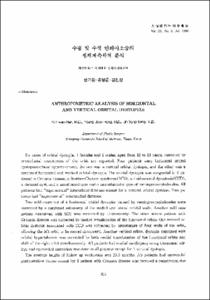KUMEL Repository
1. Journal Papers (연구논문)
1. School of Medicine (의과대학)
Dept. of Plastic Surgery (성형외과학)
수평 및 수직 안와이소증의 생체계측학적 분석
- Keimyung Author(s)
- Han, Ki Hwan; Kang, Jin Sung
- Department
- Dept. of Plastic Surgery (성형외과학)
- Journal Title
- 대한성형외과학회지
- Issued Date
- 1996
- Volume
- 23
- Issue
- 4
- Abstract
- Six cases of orbital dystopia, 4 females and 2 males, aged from 12 to 23 years, corrected by craniofacial osteotomies of the orbit are reported. Four patients were horizontal orbital dystopias (orbital hypertelorism), the one was a vertical orbital dystopia, and the other was a combined horizontal and vertical orbital dystopia. The orbital dystopia was congenital in 6 patients: a Crouzon disease, a Saethre-Chotzen syndrome(SCS), a cleidocranial dysostosis (CCD), a dermoid cyst, and a nasofrontal type and a nasoethmoidal type of meningoencephaloceles. All patients had "supernormal" interorbital distance except for a vertical orbital dystopia. Two patients had "supernormal" intercanthal distance.
Two mild cases out of 4 horizontal orbital dystopias caused by meningoencephaloceles were corrected by a combined osteotomy of the medial and lateral orbital walls. Another mild case patient associated with SCS was corrected by medial translocation of the functional orbits. One vertical orbital dystopia associated with CCD was corrected by osteotomies of four walls of the orbit, allowing the left orbit to be moved downward. Another vertical orbital dystopia combined with orbital hypertelorism was corrected by both medial translocation of the functional orbits and shift of the right orbit simultaneously. All patients had medial canthopexy using transnasal wiring, and epicanthal correction was done in all patients except for 1 vertical dystopia.
The average length of follow-up evaluation was 29.5 months. All patients had uneventful postoperative course except for 1 patient with Crouzon disease who received a reoperation due to an infection. Postoperatively, general appearances were satisfactory. The interorbital distance was returned to within normal range except for 1 patient who showed "subnormal" range. The Intercanthal distance was within normal range in all patients.
Horizontal and vertical orbital dystopias were effectively corrected by various osteotomies of the orbital walls according to the degree of the dystopic orbit. However, in the case of severe horizontal orbital dystopia, the intercanthal distance was not reduced in relation to reduction fo interorbital distance. Key Words: Vertical and horizontal orbital dystopias ,Orbital osteotomy
저자들은 수평 및 수직 안와이소증을 가진 6례의 환자를 대상으로 안와간격의 정도에 따라 다양한 방법의 안와절골술로써 교정하였다. 수술 후 안와간격과 내안각간격을 생체계측하여 수술 전과 같은 성의 연령층의 표준 정상치와 비교하여 보았을 때 증례 수는 작지만 다음과 같은 지견을 얻을 수 있었다.
가. 감염된 1례를 제외하면 수술 수 합병증이 없었으며, 시력 장애 등의 후유증이 발생하지 않았다.
나. 경도의 수평 안와이소증에서 안와골 내벽 및 외벽절골술과 U형 절골술은 믿을 만한 방법이었다.
다. U형 절골술은 경도의 안와간격을 좁힐 수 있을 뿐만 아니라 상악골 기형도 교정할 수 있는 장점이 있다.
라. 중증의 수평 안와이소증에서는 기능적 안와골 내측전위술과 과도한 내안각고정술을 하더라도 수술 수 안와간격이 좁아지는 만큼 내안각간격이 좁아지지 않기 때문에 결과가 만족스럽지 못하였다.
마. 수직 안와이소증에는 기능적 안와골의 수직 치환술이 믿을 만한 방법이었다.
- Alternative Title
- ANTHROPOMETRIC ANALYSIS OF HORIZONTAL AND VERTICAL ORBITAL DYSTOPIAS
- Publisher
- School of Medicine
- Citation
- 한기환 et al. (1996). 수평 및 수직 안와이소증의 생체계측학적 분석. 대한성형외과학회지, 23(4), 921–933.
- Type
- Article
- ISSN
- 1015-6402
- Appears in Collections:
- 1. School of Medicine (의과대학) > Dept. of Plastic Surgery (성형외과학)
- 파일 목록
-
-
Download
 oak-bbb-1727.pdf
기타 데이터 / 1.07 MB / Adobe PDF
oak-bbb-1727.pdf
기타 데이터 / 1.07 MB / Adobe PDF
-
Items in Repository are protected by copyright, with all rights reserved, unless otherwise indicated.